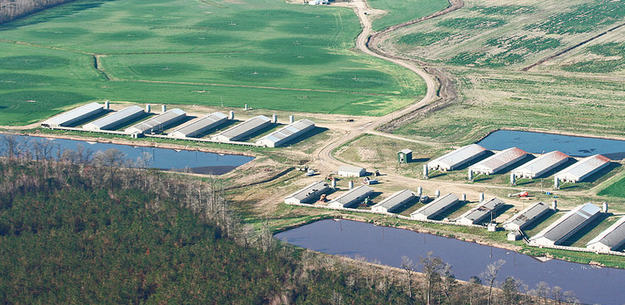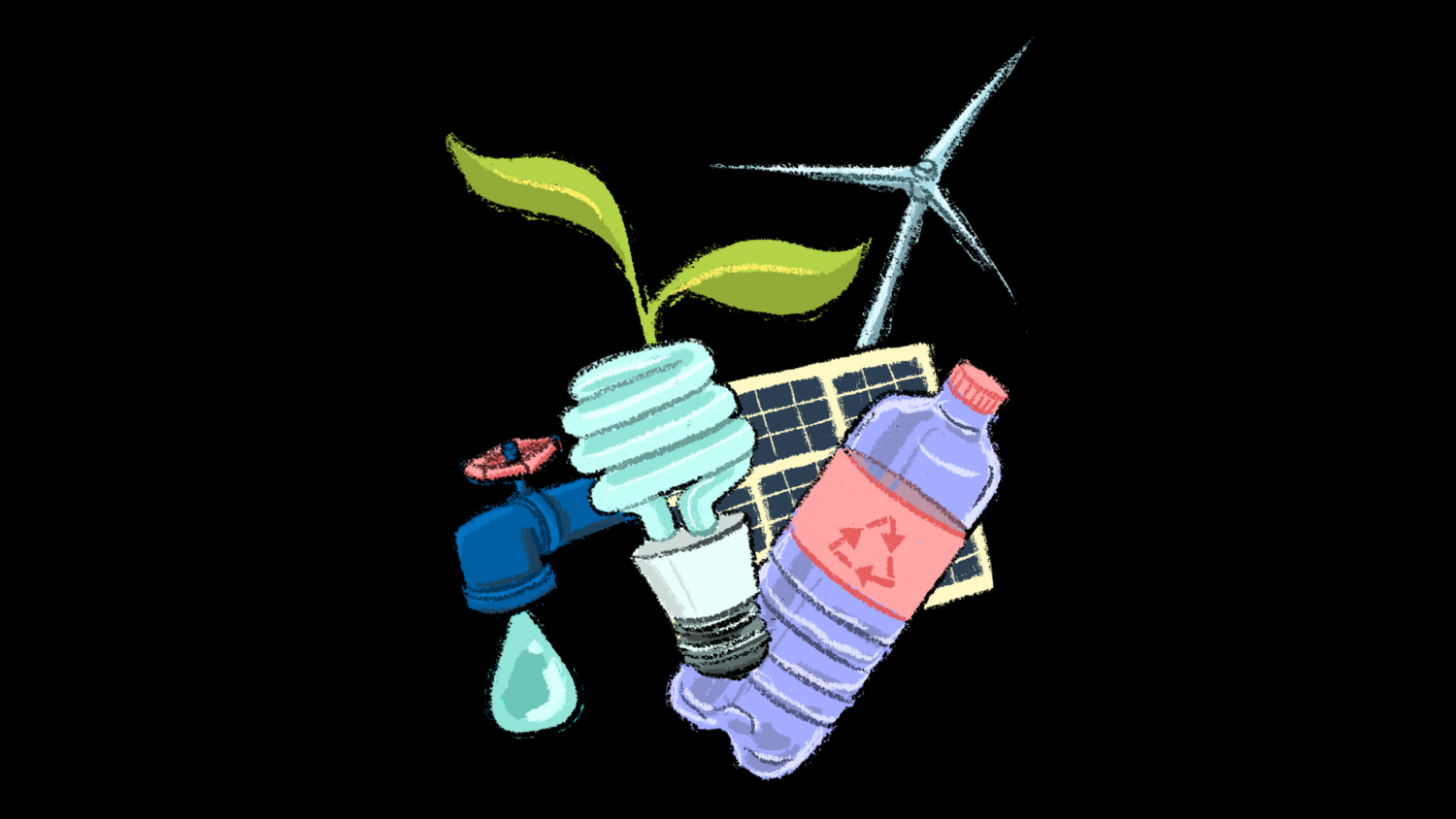HOG WASTE POWER PROTECTS WATER & PROVIDES CLEAN ENERGY TOO

A large-scale, conventional hog waste lagoon on a farm in North Carolina. Photo: Waterkeepers Alliance/creative commons
Hog waste has long been a source of trouble for North Carolina, but now it’s becoming a source of energy. Late last month, Storms Hog Farms cut the ribbon on its Storms Hog Power facility in Bladenboro, NC, which uses anaerobic digestion to convert hog waste into a source of renewable energy. The Storm Hog Power facility is the sixth such facility in North Carolina, and the largest one to date.
Each day, the farm collects the manure from 30,000 hogs and places it into a 1.2 million gallon concrete chamber, where it mixes with anaerobic bacteria that help break it down, destroying pathogens and odor and producing methane gas. This biogas is then burned as a fuel source, generating enough electricity to power nearly 300 average size homes. The byproduct can be converted into nitrogen and phosphorous fertilizers.
Hazardous hog waste
Hog farming has long been a part of agriculture in North Carolina, but the industrial practices that now dominate the hog industry in the eastern region of the state began taking shape in the late 1980’s. As Journalist Christopher Leonard has explained in detail, consolidation in the pork industry made it increasingly difficult to raise pigs independently. Smaller farms were replaced with high density, industrial operations, where thousands of pigs are raised in confined spaces.
Traditionally, farmers flushed hog waste into open air lagoons, where it would break down anaerobically before being sprayed back onto fields. Although this method proves relatively safe and effective on a small scale, the industrial-scale lagoons quickly became a major source of concern.
The large lagoons produced a terrible smell, and researchers in the late 90’s confirmed that people living around hog farms are more likely to experience respiratory symptoms, decreased lung functions and increased pollutants in their lungs. The sludge that farmers spray onto their fields often contains more nutrients than their plants can absorb. Excess nutrients run off into surrounding water ways, leading to algal blooms and fish kills.
Pig feces contain far more pathogens than human waste, making the murky lagoon waters a major public health concern when they spill out of their pit. This happened on a massive scale in 1999, when Hurricane Floyd flooded much of the eastern part of the state. On such occasions, dangerous viruses and bacteria, like antibiotic resistant staph (commonly known as MRSA), can seep into the ground water and infect the surrounding community. MRSA kills over 10,000 people each year in the US, and researchers at John Hopkins have recently published a study linking high infection rates with proximity to high density hog farms.
Lagoons that won’t go away
The North Carolina General Assembly placed a temporary moratorium on new hog farms using the traditional lagoon and spray waste disposal method in 1997, and passed this moratorium into law in 2007. In 2000, Attorney General Mike Easely negotiated an agreement with Smithfield Foods to phase out the use of lagoons, replacing them with environmentally superior technology. Smithfield pledged $15 million for research into alternative waste disposal methods, and $50 million for environmental improvement projects.
Although researchers have tested a number of different alternative technologies, few of the lagoons that were in use in 2000 have been phased out. A number of technologies meet the criteria for “environmentally superior technology,” but none have proven economically feasible, as defined by the agreement. The General Assembly created a Lagoon Conversion Program in 2007 to help shoulder the high cost of alternative technologies, but to date only a handful of applicants have applied, and many proposed projects were abandoned due to concerns about high operating costs.
Searching for an economically viable alternative
Storms Hog Farm’s anaerobic digester processes the manure of 30,000 hogs in a way that substantially reduces odor, emissions and runoff, yet it will likely be many years before open air lagoons become a thing of the past. Funding for the Storms Hog’s digester came in part from a $1.5 million US Treasury grant, and a $1 million state tax credit. The overall cost of the project came out close to $5 million. Though the price will likely come down in the years to come, other hog farmers will only replace lagoons with costly digesters if they can offer enough steady revenue to make the initial investment worthwhile.
North Carolina Electric Membership Corporation has a long-term contract to buy all of the energy that the Storms Hog Power plant produces. North Carolina’s Renewable Energy and Energy Efficiency Portfolio Standard mandates that investor-owned utilities source .2% of their energy portfolio from swine waste by 2018, which should help make methane digesters more economically viable in the future.
Carbon credits could offer an additional source of revenue in the future. Methane is twenty-one times more effective at preventing radiation from leaving the planet than carbon dioxide. The methane off-gassing into the atmosphere from the open-air lagoons is a major contributor to climate change. Some corporations and universities are voluntarily attempting to offset their carbon emissions, purchasing carbon offset credits from projects that reduce greenhouse gas emissions. Every ton of methane that an anaerobic digesters keeps out of the atmosphere could offset twenty-one tons of carbon. Demand for offsets credits remains relatively low today, but climate legislation could increase demand in the future, making anaerobic digesters a better investment.
Cleaning up this mess
Fifteen years after the Smithfield Agreement was signed, waste disposal practices on hog farms remain largely unchanged. The open air lagoons remain filled with pathogen-rich fecal matter, still in danger of flooding if another bad hurricane hits the coast.
Earlier this month, 588 eastern Carolina residents filed farm nuisance complaints against Smithfield Foods, arguing that stench, flies and pollution from hog farms have deprived them of use and enjoyment of their property. If the complaints are not settled in mediation, the complainants will file a lawsuit.
Although alternative waste disposal technologies have improved a great deal since the early 90’s, many farmers will continue to use the lagoon and spray system until regulatory pressure or economic incentives make the alternatives more attractive. Three decades ago, hogs were so profitable they were known as “mortgage lifters,” but now contract hog farmers often struggle to earn enough to pay off their existing mortgage, making the prospect of taking out another loan to finance an anaerobic digester seem daunting. Last year, China’s Shuanghui Group bought Smithfield Foods for 7.1 billion dollars, but so far the parent company have not committed any funds to help clean up the waste that their hogs produce.
“North Carolina produces more than 9 million hogs each year, and each hog produces ten times the fecal waste as humans. The current disposal system poses major environmental and health challenges. It remains to be seen, however, if alternatives can be financed at a scale large enough to address the problem unless demand for offsets and hog waste power increases. The Storms Hog Power plant offers a glimpse of what the future could look like if we stop seeing hog manure as waste and start viewing it as a valuable, renewable energy source.
- Categories:


